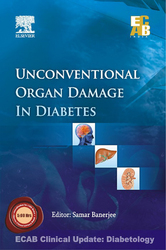「重要なお知らせ:日本語書籍をご購入いただき、eLibraryをご利用の皆さまへ」
エルゼビアは、より快適にサービスをご利用いただくため、システムの重要なアップデートを実施いたします。
現在、新サイト、eBooks+への移行が進められています。
新規ユーザー登録および書籍の登録はElsevier eLibraryでは停止しております。
12月15日以降に
こちらよりご利用・ご登録ください。
Book Description
Cell health depends on a steady supply of fuel from glucose and free fatty acids. Both these major fuels are regulated by insulin. Cells in the muscle, liver, and fat need insulin to receive glucose, and hence do not become exposed to high blood glucose levels when the blood sugars are high and insulin levels are low. The lack of insulin slows the movement of glucose into these cells, and probably spares them from damage when blood sugars are high. However, other cells such as those in the brain, nervous system, heart, blood vessels and kidneys pick up glucose directly from the blood without using insulin. These cells, except the brain, are more prone to damage from high blood sugars because they become exposed to high internal levels of glucose. This to quite an extent explains why damage tends to occur in specific organs such as in nerve and kidney cells, and in small blood vessels like those in the eyes. This project on the organ damage in diabetes is an attempt to elaborate on the various factors to be considered in managing these patients, the pointers for early diagnosis and prevention of the same.


 (0 rating)
(0 rating) 




